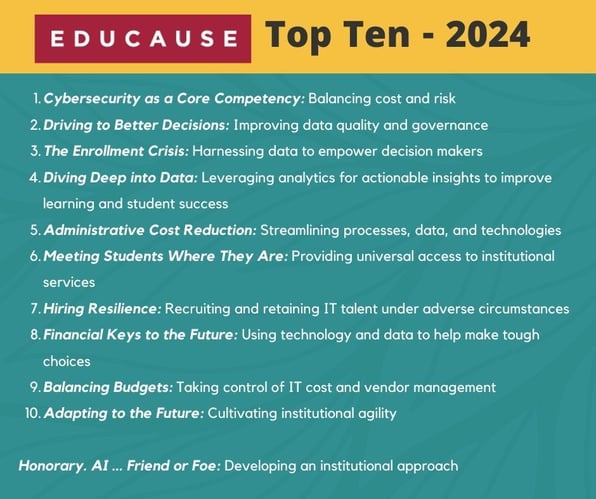How curriculum management can advance institutional resilience in 2024
Given the challenges universities are expected to face in 2024 and beyond, higher education leaders are increasingly focused on helping their universities become more adaptable and agile. To weather the tough times ahead, they must not only prioritise growth and innovation but continued institutional resilience.
The EDUCAUSE Top 10 describes the contributions that technology, data, and the workforce make to advance institutional resilience. For 2024, EDUCAUSE recommends the following as key priorities for higher education:

As more institutions begin to develop their 2030 strategy, it’s perfect timing to explore how curriculum management can meet these top 10 priorities. We explore, through the context of these priorities, how curriculum management can form the basis for institution-wide transformation.
Better data, better decisions
Within every institution, academic and professional services staff require a huge amount of curriculum data. Therefore it makes sense that the business processes and systems used to manage this data need to be comprehensive yet simplified enough to be efficient. However, many institutions still struggle with the basics of data management and governance.
The problem often starts with data ownership. More often than not, academic faculties can feel like they are owners of the curriculum data they design. But curriculum data overall is inherently an institutional asset that must be captured, stored and maintained in a standardised way that protects its integrity. The siloed mechanisms used to capture and manage data can lead to duplications, errors and poor quality.
As a starting point, institutions can invest in a definitive source of truth for all curriculum data – that is, a central repository for collecting, storing and reviewing all curriculum data. Policies used for approving and governing curriculum data once it's in this repository is equally as important. Robust data governance ensures curriculum updates and new proposals are approved swiftly and correctly.
When data management and governance processes are mature and stable, institutions can better capitalise on their data, leveraging it to help with strategic decision-making, curriculum updates and new academic proposals.
Connecting curriculum management to student success
The higher education landscape is changing at an incredible pace. Academic staff, learning designers and instructors are adopting newer tools to improve what they teach and how they teach. Business professionals are working to improve the student experience, investing in resources such as career advising, wellbeing and financial aid. But there must also be adequate investment into curriculum management digital transformation.
There is a hugely understated connection between curriculum management and student success. It underpins much of the student journey, beginning with recruitment and enrollment before moving along many touch points across a student’s academic journey.
At every stage of their journey, students rely on up-to-date curriculum information to make conscious decisions about their study. Visible curriculum helps incoming prospective students understand what they’re studying, including any prerequisites, course outcomes and study modes. When they’re a student, it supports student advising, empowering them to create a clear and actionable pathway to long-term success.
Curriculum management transformation is an opportunity for all institutions to review, refresh, strengthen and consolidate the way they manage curriculum in order for them to deliver a quality student experience.
Using technology to achieve administrative efficiency
Universities have always sought ways to optimise operations, reduce administrative costs, and improve staff satisfaction. While they have made significant strides in these areas, there are still savings to be made through simplifying and standardising processes.
At most universities, curriculum administration often remains a manually-intensive, complex and time-consuming task. Without rich and robust technology, staff are reliant on excel spreadsheets, word documents and email chains – all of which jeopardise compliance and quality.
The curriculum management system is more-often-than-not overlooked when leaders consider how to optimise their budgets and operations, yet, transforming how curriculum is created, approved and published significantly reduces administrative costs and effort.
A standardised curriculum management process, often a result of an end-to-end curriculum management system, leads to cleaner single-source data which makes reporting easier, reduces administrative errors and provides better insights and decision-making.
Furthermore, a dedicated curriculum management system enables institutional competitiveness and agility. Academic staff are able to identify any errors in the curriculum and take steps to remediate any risks quicker. These all play a role in continued institutional agility and innovation.
For years, we’ve spoken about curriculum management digital transformation and how a shift in strategic thinking, processes and technology can help transform institutional operations and build resilience. We are thrilled to see curriculum management begin to be recognised as a key area of focus for many higher education leaders in 2024 and beyond.

